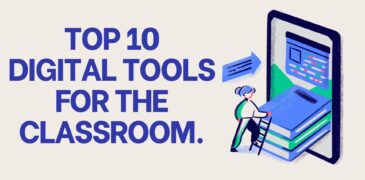In today’s educational landscape, digital tools have become integral to modern classrooms, revolutionizing teaching and learning experiences. From interactive whiteboards and educational software to online collaboration platforms and multimedia resources, these digital tools offer educators innovative ways to engage students and enhance their understanding of diverse subjects. With the ability to personalize instruction, facilitate communication, and provide access to a wealth of educational resources, digital tools empower educators to create dynamic and interactive learning environments that cater to the diverse needs and learning styles of their students, preparing them for success in the digital age.
Top Digital tools for the classroom
Google Classroom
Google Classroom is a versatile and user-friendly platform designed to streamline classroom management and enhance collaboration between teachers and students. Key features include assignment creation and distribution, online grading, class discussions, and file sharing. Teachers can create assignments, quizzes, and announcements seamlessly, while students can access course materials, complete assignments, and collaborate with peers in a centralized digital environment.
Google Classroom promotes accessibility, as course materials are accessible from any device with an internet connection, enabling learning anytime, anywhere. Integration with other Google Workspace apps enhances productivity, allowing for seamless integration of documents, presentations, and spreadsheets into classroom activities.
ClassDojo
ClassDojo is a powerful platform dedicated to fostering seamless connections between teachers, families, and students, creating a supportive learning community. The features of ClassDojo encompass a range of tools designed to enhance communication, engagement, and collaboration.
One key feature is the instant messaging system, enabling effortless communication among teachers, families, and staff. Messages are automatically translated into over 35 languages, ensuring inclusivity and accessibility for everyone. This real-time connection facilitates quick updates, queries, and valuable interactions.
The Stories feature offers a captivating window into the classroom, allowing teachers to securely share photos, videos, and updates with parents. This private feed provides a firsthand glimpse into the learning experiences, creating a sense of involvement and understanding.
Socrative
Socrative is an innovative educational technology platform designed to enhance classroom engagement, assessment, and interaction. The platform offers a myriad of features that cater to both educators and students, fostering an interactive and dynamic learning environment.
One standout feature of Socrative is its real-time assessment capabilities. Educators can create quizzes, polls, and assessments that students can respond to instantly using their devices. This instant feedback mechanism not only gauges understanding but also allows for adaptive teaching strategies, addressing learning gaps in real-time. The variety of assessment formats, including multiple-choice questions, short answers, and true/false, ensures flexibility in evaluating diverse topics and learning objectives. Socrative’s versatility extends to its integration with other educational tools, enabling seamless incorporation into existing classroom workflows.
Edpuzzle
Edpuzzle is an educational platform that enriches traditional video content by allowing teachers to create interactive lessons, fostering student engagement and comprehension. The platform offers a range of features designed to enhance the learning experience.
One of Edpuzzle’s key features is the ability to turn passive video-watching into an interactive learning process. Educators can embed questions, quizzes, and audio notes directly into videos, ensuring that students actively engage with the content. This interactive layer promotes comprehension, critical thinking, and retention.
Edpuzzle supports a variety of video sources, allowing teachers to utilize existing video content or create their own. This flexibility ensures that educators can tailor lessons to align with specific curriculum requirements and learning objectives.
Kahoot
Kahoot! is a dynamic educational platform that transforms learning into an interactive and game-based experience, fostering engagement and knowledge retention. The platform’s features and benefits are tailored to create an immersive and enjoyable learning environment for both educators and students.
One standout feature of Kahoot! is its ability to turn assessments and reviews into competitive and collaborative games. Educators can create quizzes, surveys, and discussions that students respond to in real-time using their devices. This gamified approach not only promotes healthy competition but also encourages active participation and deeper understanding of the material.
Quizlet
Quizlet is a versatile learning platform that empowers students and educators with a range of features designed to enhance the study experience. The platform’s adaptability and comprehensive tools contribute to efficient and effective learning outcomes.
A key feature of Quizlet is its robust flashcard system. Users can create and customize flashcards, allowing for the efficient memorization of terms, definitions, and concepts. Quizlet’s flashcard format supports various learning styles, promoting active recall and reinforcing key information.
The platform offers a variety of study modes, including Quizlet Learn, which utilizes adaptive learning algorithms to tailor study sessions based on individual progress. This personalized approach enhances retention and comprehension, adapting to each user’s strengths and weaknesses.
Nearpod
Nearpod is an innovative educational platform that transforms traditional teaching methods into interactive and engaging experiences for students and teachers alike. The platform’s features are designed to enhance classroom engagement, collaboration, and real-time assessment. One of Nearpod’s standout features is its interactive lessons, which educators can create by embedding multimedia content, such as 3D objects, virtual reality simulations, and quizzes. This multimedia integration caters to diverse learning styles, fostering a dynamic and immersive learning environment.
Real-time collaboration is facilitated through Nearpod’s ability to sync lessons across multiple student devices, enabling simultaneous participation and interaction. Students can respond to polls, quizzes, and open-ended questions in real-time, providing instant feedback to teachers and promoting active engagement.
Flipgrid
Flipgrid is an innovative video discussion platform that empowers educators and students to engage in meaningful and collaborative conversations. The platform’s features are designed to enhance communication, creativity, and community building within the educational setting.
A standout feature of Flipgrid is its video response mechanism, allowing students to share their thoughts, ideas, and projects through short video clips. This promotes effective communication, fosters public speaking skills, and provides a dynamic alternative to traditional written assignments. Flipgrid’s versatility is evident in its ability to support a wide range of learning activities, including discussions, debates, project showcases, and reflective journals. Educators can create topics and pose questions, inviting students to respond and engage in interactive discussions, thus promoting a sense of community and collaboration.
Pear Deck
Pear Deck is an interactive presentation platform designed to elevate classroom engagement and facilitate real-time interaction between educators and students. With a range of features, Pear Deck transforms traditional presentations into dynamic, student-centered learning experiences.
A central feature of Pear Deck is the ability to add interactive elements to presentations, such as quizzes, polls, and open-ended questions. This fosters active participation, enabling educators to gauge student understanding, address queries, and adapt their teaching in real-time.
The platform promotes student collaboration through its integration with Google Workspace, allowing students to engage with presentations on their devices. This collaborative environment encourages peer-to-peer interaction, discussion, and the co-creation of knowledge.
Zoom
Zoom is a versatile and widely-used video conferencing platform that has become instrumental in facilitating virtual communication, collaboration, and remote learning. One key feature of Zoom is its high-definition video and audio capabilities, offering clear and reliable communication. The platform supports virtual meetings, webinars, and collaborative sessions, enabling users to connect from different locations in real-time.
Zoom’s user-friendly interface allows for easy scheduling and joining of meetings, making it accessible for users of all technical levels. The platform’s compatibility with various devices, including desktops, laptops, tablets, and smartphones, ensures flexibility in accessing meetings from anywhere.
Conclusion
In conclusion, digital tools for the classroom have revolutionized traditional teaching methods, creating dynamic and interactive learning environments. From fostering effective communication between teachers, families, and students to providing innovative platforms for interactive lessons and assessments, these tools have reshaped education. Features like real-time collaboration, multimedia integration, and personalized learning contribute to enhanced student engagement and comprehension. The versatile nature of these tools accommodates various learning styles and settings, promoting flexibility and inclusivity. As technology continues to evolve, digital tools stand as invaluable assets, bridging gaps in education and offering educators and students powerful resources for a more enriching and connected learning experience.
Read more:







